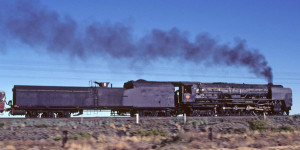Gordon Garnhart
There were 32 people gathered at the Summer Hill Retirement Facility on Wednesday, March 15th. John White opened the meeting with an introduction of Susan Gonzales as the new program organizer. She distributed a sheet of ideas for future programs and led a lively discussion about them.
The main program of the evening was a showing of a series of still photographs and videos of steam railroading taken by Rich Thom. By the 1980s, steam had disappeared from most of the world’s railways, and large numbers of steam locomotives remained in service in only three places: China, India, and South Africa. South African steam was some of the most unique anywhere, with designs tailored to the region’s railway lines, laid mostly with light rail, steep grades, and sharp curves. South Africa was the first to use the 4-8-2 “Mountain” wheel arrangement, years before the USA, and also famous for its Garratt locomotives, an articulated design widely used in Africa, Australia, and many other parts of the world, but never adopted in America. Steam development culminated with 4-8-4 locos, including the famous condensing locos that hauled both freight and passenger trains on the double track main crossing the waterless Great Karoo. And all this was narrow gauge–South Africa’s rails are laid to a gauge of only 3’6”.

One of the magnificent Class 25NC 4-8-4's running at 55 mph on the double tracked De Aar to Kimberly mainline
This program was based on two visits to the region: one in 1980, to both the Republic of South Africa and its northern neighbor Zimbabwe, where together well over 1,000 steam engines were still in service. The steam fleet of the National Railways of Zimbabwe (formerly Rhodesia Railways) was 100% Garratts at that time. A second visit was made in 2000, when only “museum” steam remained in South Africa. The program included both still photos and video.
Along the way, Rich included the story of the Garratt design; visited the “Big Hole” in Kimberley (which produced over 14 million carats of diamonds); the Victoria Falls on the Zambezi River; the engineering features of the great 4-8-4 condensers; and of course (since this is Africa!) some four-legged critters, too. He also showed a ride behind the “Baby Garratts” on South Africa’s “narrow-narrow” gauge–2-foot gauge miniatures of their larger 3’6” gauge counterparts. His travels covered several rail lines from Capetown in South Africa to Victoria Falls in Zimbabwe. As always, he provided a running commentary filled with historical facts, statistics, and humorous remarks that held everyone’s attention for over 90 minutes.
Our next meeting will be on Wednesday, April 9th at 7:00 PM in Summer Hill Retirement Facility and will feature Mr. Di Voss, who will talk about “The Reality and Model of the Everett & Monte Cristo” and will also judge the entries in our weathered rolling stock competition. This promises to be a very interesting program. See you there.


No Comments Yet